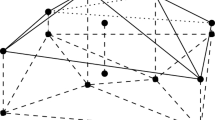Abstract
The parameter estimation of the nested logit model is conducted either simultaneously or sequentially. This is well known fact that the sequential method yields less efficient estimates than the simultaneous one, although its estimates are consistent and asymptotically efficient. Due to the computational burden, however, the sequential estimation is more often employed. Recently, the genetic algorithm has received a great deal of attention for its efficient solution for the nonconvex multidimensional problem. Generally, the parameter calibration of the nested logit model is nonconvex and hence, its solution may not be a global one. A hybrid estimation algorithm combining GA and the gradient method for the simultaneous nested logit model estimation has been suggested. The hybrid algorithm is implemented in a code, named G-Logit. An experimental test results, although limited, showed that the hybrid algorithm effectively search the solution domain of the nested logit model calibration and produced better estimates than the solely used gradient method.
Similar content being viewed by others
References
Amemiya, T. (1978). “On a Two-Step Estimation of a Multivariate Logit Model.”Journal of Econometrics, Vol. 8, pp. 13–21.
Ben-Akiva, M. and Lerman, S.R. (1979).Disaggreate Travel and Mobility Choice Models and Measures of Accessibility.In Behavioral Travel Modeling, D. hensher and P. Stopher. eds. Croom Helm, London.
Ben-Akiva, M. and Lerman, S.R. (1987)Discrete Choice and analysis-Theory and Application to Travel Demand. MIT Press, Cambridge, Massachusetts.
Coley, D.A. (1996)Genetic Algorithms, Contemporary Physics, Vol 37, No. 2, pp. 145–154.
Daly, A. J. and Zachary, S. (1979).Improved Multiple Choice Models.In Identifying and Measuring the Determinants of Model Choice, D. Hensher and Q. Dalvi, eds. Teakfield, London.
Davis, L. (1991).Handbook of Genetic Algorithm, Van Nostrand Reinhold, New York.
De Jong, K.A. (1992).Are genetic algorithms function optimizes?, R. Manner and B. Manderick (ed.), Parallel Problem solving form nature, Vol. 2, pp. 3–13.
Gen, M. and Cheng, R. (1997).Genetic Algorithms and Engineering Design, John wiley & Sons, Inc, New York.
Goldberg, D.E. and Segrest, P. (1987). “Finite Markov chain analysis of genetic algorithm. J.J. Grefenstette (ed.). Genetic Algorithms and their applications.”Proc. of the Second International Conference on Genetic Algorithms, pp. 1–8.
Holland, J. (1975).Adaptation in Natural and Artificial Systems, University of Michigan Press, Ann Arbor.
Iba, H. (1999)Principle of Genetic Algorithm, Oum Inc. Tokyo. (In Japanese edition).
Japan Society of Civil Engineering (1995).Theory and Application of Disaggregate Behavior Model, Maruzen Inc. (In Japanese edition).
Lee, C. (1998). “Combined Traffic Signal Control and Traffic Assignment: Algorithms. Implementation and Numerical Results.” PhD dissertation, The University of Texas at Austin.
Man, K.F., Tang, K.S. and Kwong, S. (1996). “Genetic algorithms: concepts and application.IEEE Transactions on Industrial Electronics, Vol. 43, No. 15, pp. 519–534.
McFadden, D. (1987).Modeling the Choice of Residential Location.In Spatial Interaction Theory and Residential Location, A. Karlquistet al., eds., North Holland, Amsterdam, pp. 75–96.
Williams, H.C.W.L. (1977). “On the Formation of Travel Demand Models and Economic Evaluation Measures of User Benefit.”Envir. And. Planning 9, pp. 285–344.
Author information
Authors and Affiliations
Corresponding author
Rights and permissions
About this article
Cite this article
Ryoo, S.K., Lee, C.W. Genetic algorithm and simultaneous parameter estimation of the nested logit model. KSCE J Civ Eng 8, 129–133 (2004). https://doi.org/10.1007/BF02829088
Received:
Accepted:
Issue Date:
DOI: https://doi.org/10.1007/BF02829088




